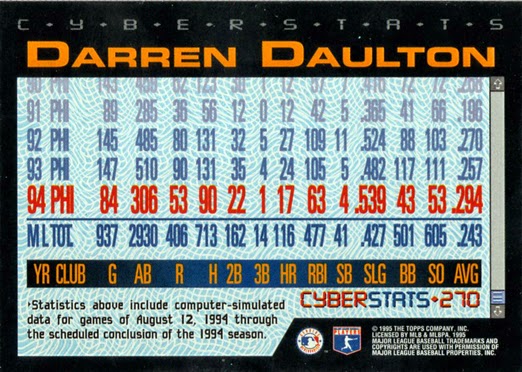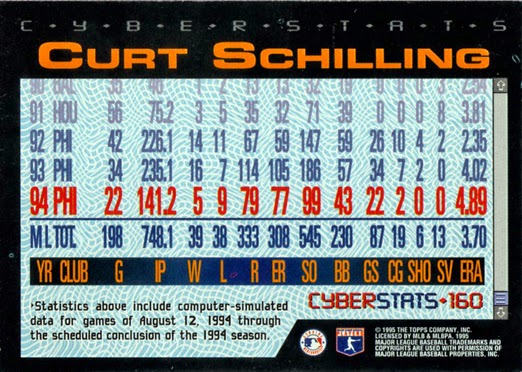The 1994 baseball season ended in mid-August due to the failure of the owners and players to reach a new contract deal. I don't want to dwell on the reasons for and the effects of that work stoppage except to remark on one of the least important effects, Topps attempts to produce a set of baseball cards to take advantage of the situation. They produced two in fact, the Topps Cyberstats Parallel and the Stadium Club Virtual Reality Parallel sets. I'm going to deal with the Cyberstats set as I recently acquired the Phillies cards from this set.
Here's what the regular 1995 Topps cards looked like:
1995 was, in my opinion, a nice set. The deckle edged border on the front was something different. By now gold foil was commonplace even on base sets. I really like the backs. The managed to fit full career stats, a portrait in "Diamond Vision" and a small player figure.
Here's the front of the Cyberstat parallel.
The front uses the same photograph but with a foil dufex background. The logo and the player name are holographic foil. The back is radically different.
Topps, according to the back of the card, used a computer simulation to play the remaining games of the season. For the Phillies that was 47 games. The 1994 stats given are the total of the players actual stats for the season plus the stats from the simulated games. I have no idea how sophisticated baseball computer simulation was in 1995. I've checked for several players and the stats are different than just extrapolating out to 162 games. Note also that the stats are displayed in a simulated computer window. Windows 95 I guess had just been released.
There were only 396 cards in the set. They were inserted one per pack of Topps. They are all straight player cards, no All-Star, rookie, or any of the other subsets in 1995 Topps.
In 1993, Dave Hollins, like many Phillies had a great year. In 1995, if I remember correctly, he broke a small bone in one of his hands which severely limited his playing time for several years. No wonder his simulated 1994 stats look so different than in 1992 and 1993 stats.
Danny Jackson could have had the second best season of his career. He'd already won 14 games by the premature end of the season. Jackson played 3 more years after 1994 and managed to only win 7 more games.
Topps projected Jones to save 33 games. He'd already had 27.
Kruk really had 5 home runs in 1994. The Topps projection gives him 4 more. In 1995, Kruk went to the White Sox and retired the day he got his 100th home run. He could have retired a few days sooner.
Munoz already had 7 wins, the best by far of his career when play stopped. I doubt he'd have won another 7. He played 5 more years after 1994 and only won 1 more game.
I don't remember why but Schilling was having a terrible year in 1994. He was only 2-8 with only 13 starts when the season ended. In '93 he'd been 16-7 in 34 starts. Topps projects him to have been 5-9 with a career worst (as a starter) ERA of 4.89.
Subscribe to:
Post Comments (Atom)




















No comments:
Post a Comment